Background
As far as we can tell, no WTMC club trip has visited Pell Stream hut in the Lewis Pass area in recent years. The hut is considered to be ‘remote’, receiving few visitors. This was the club’s third attempt to get to Pell Stream hut since January 2016, and Catherine, David, and I had signed up for all three trips. At Wellington Anniversary Weekend in January 2016 it was initially listed as an Easy trip. But with only two people keen to go, Pell Stream was merged with David’s Easy-Medium tramp to nearby Lake Daniells and so eight headed out to visit both locations. The Maruia River looked rather swift so the group took the Lake Daniells track as far as the junction of the Alfred River and Pell Stream, then walked east along the stream until we came to the start of the extensive gorge section. The map showed that river travel would be unwise. Much time was spent trying to locate the beginning of the track but by the time we found it, it was too late to set off along a route we suspected might be a bit difficult. So we gave up on Pell Stream hut and enjoyed an idyllic afternoon on Frazer’s Flat, relaxing in the sun, swimming, and camping stream-side, and proceeded to Lake Daniells the following day.
Our second attempt should have been January 2017 but a weather ‘bomb’ (or ‘bomb low’) looked set to affect most of the South Island and all trips were called off – a very sensible decision as it turned out.
So, on to attempt number three.
Day One/Saturday: Marble Hill carpark to Pell Stream hut
We felt like pioneers as we headed out on Saturday morning in overcast but pleasant conditions. The first obstacle was the Maruia River. The river was only knee deep where we crossed but the force of the flow was considerable – enough to require all five of us to link up – and still it was hard work. From there we strolled along the pleasantly overgrown 4WD track for 3–4 kilometres. The turnoff to Pell Stream was well marked.

The track isn’t officially maintained but is marked with a combination of Permolat, pink spray paint, and pink or orange tape so we had no trouble keeping to it. Where the track ran close to Pell Stream there were some narrow sections high above the river. Walking through the beech forest we noted with relief the absence of sandflies and no humming of wasps. Somewhere around half way the trail ended at the stream and from there we proceeded on to the hut without a marked route. Apparently there are markers but we weren’t much good at spotting them.
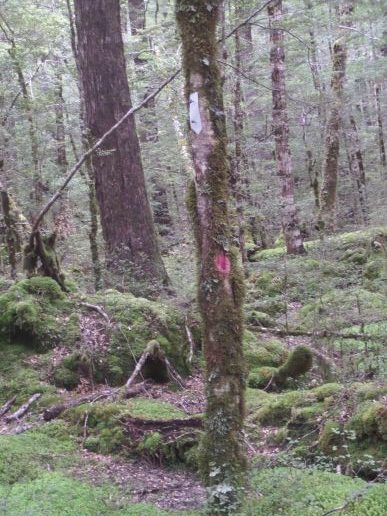
Pell ‘Stream’ sounds like something slow and gentle, but not so: its force meant we usually chose to cross with the support of at least one other person, and sometimes all five where the crossing point was wide enough. We soon lost track of the number of times we waded across the river. Drizzle began during the afternoon and turned to light rain after a couple of hours. We walked in or alongside the stream the rest of the way and used the map to keep track of roughly where we were in relation to the hut. But progress was slow.

One of our group became very chilled from the rainy conditions and all those river crossings. The risk of developing hypothermia was a big concern. Extra clothing layers were added and the billy boiled for a warming drink but nothing could really help cold feet and wet legs. We had to take particular care when crossing the stream in this state but all varieties of terrain held potential hazards. There was not a breath of wind all day, a great blessing.
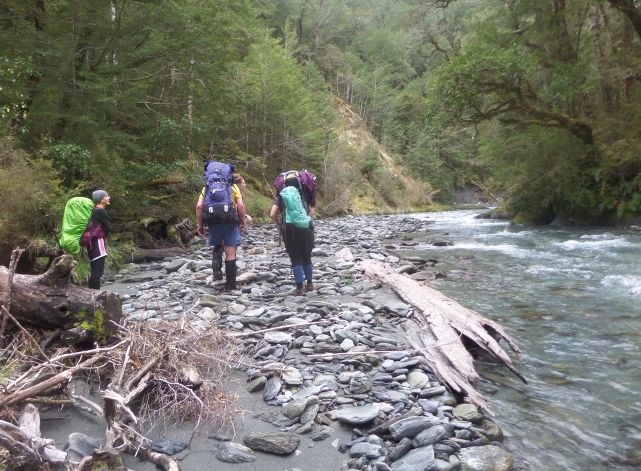
We all had our share of sliding down banks and struggling to regain the track, slips in the river, and falling over in swampy channels. Karen was adept at finding deep mud holes; I half expected her to lose a boot, such were the loud sucking sounds forthcoming when she wrenched her leg free. My turn came descending a bank ladder-wise to the river. Either a branch broke off in my hand or the bank disintegrated under my boot, but I was too busy falling backwards into the river margins to notice. I fell only half a meter and landed on my pack, and fortunately the river was only a couple of inches deep. I heaved myself forwards and the weight of the pack then pushed me face down close to the water. My knees trembled for a bit but we had to get on.
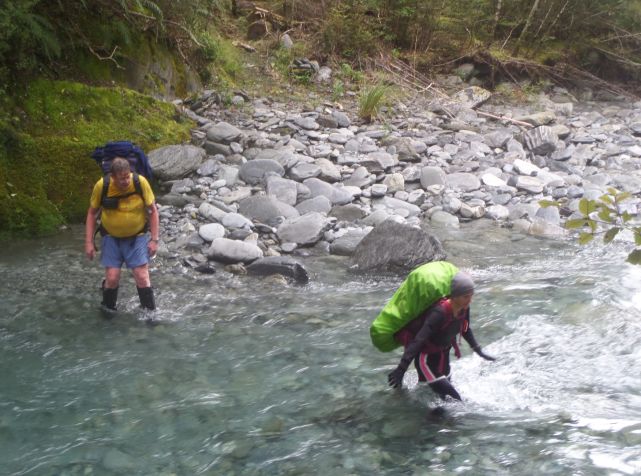
Did I mention our progress was slow? As the afternoon wore on, I’m sure we all were thinking: “I don’t want to spend the night camping out in the open!” I know I was. Everywhere was sodden.
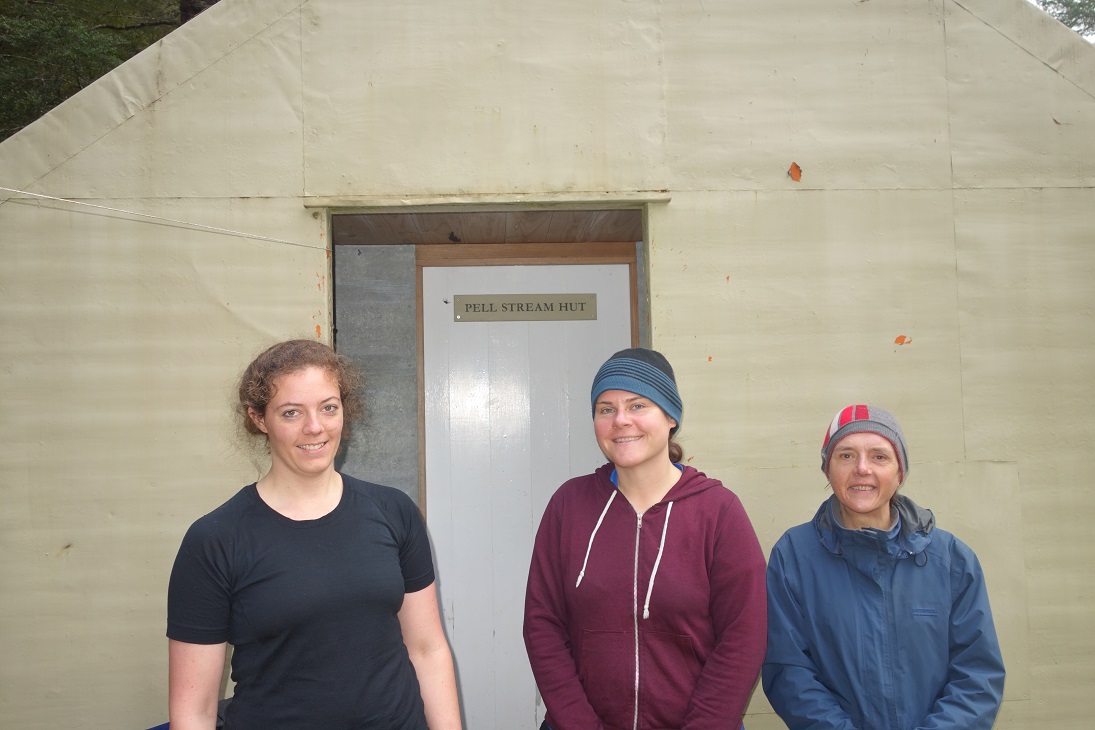
We made it to the hut at 7.20pm – an 8-hour day. When I heard the time, I realised why I had been feeling hungry. David said “I’m knackered!” and we all agreed. And as I wrote in the hut book, we were very very pleased to reach the hut. The temperature didn’t seem cool enough to need to light the fire, but a good supply of dry firewood was laid up, ready to go if we wanted it. The fireplace, however, had a pool of rainwater at the bottom thanks to a leaky chimney. Just as well we didn’t really need a fire, though we’d brought firestarters in case we needed them. The hut is a comfortable size with four bunks and floor space for another two or three. Catherine graciously offered to take the floor; we four gratefully accepted the bunks (and laid groundsheets or mats over the slightly mildewed mattresses).
Dinner, a very satisfying smoked salmon penne – no left-overs – was followed by chocolate fondue. Erika commented, “I need more fondue”, and we all agreed with that – it was very good! By then it was dark and the stars seemed especially sharp – which meant the cloud had cleared. Hopefully we’d get dry weather on Sunday.
Day Two/Sunday: Pell Stream hut to Cannibal Gorge hut
The cloud had returned by morning but as we resumed our travel upstream at 8.20, we basked in flashes of warm sunshine for a full half hour. Then the drizzle returned, and turned to rain, which didn’t really let up for the rest of the day. Oh well, we were wet anyway.
As we got higher up the valley Pell Stream became easier to cross without assistance. And as with the previous day, there were regular logjams, some quite extensive. Catherine scouted out the safest routes but occasionally we had to back-track when a path became too difficult. Our journey was sometimes in the river or hugging its banks and sometimes climbing over logjams or bush bashing along river terraces or through swamps. Fortunately we never came across anything we couldn’t find a way over or around. For all its obstacles, following the river made for a nice gentle way to gradually ascend.
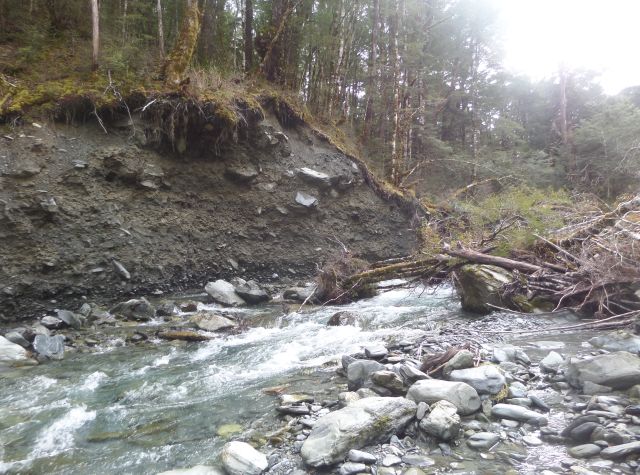
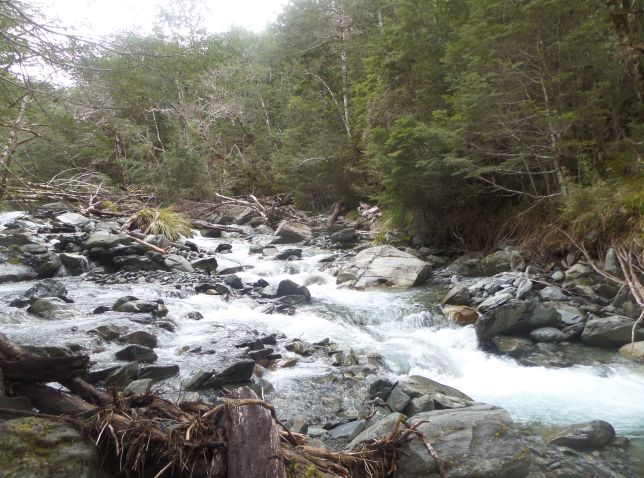
Around 1.30 we were hungry. We’d reached an open flattish area but it was too wet to eat out in the open so we lunched standing under some trees at the edge of the hillside. After a short break we headed across the stream, into the trees, and began the ascent to the saddle.

The beech forest seemed reasonably open but the understorey of beech saplings and other small trees like mingimingi proved quite hard going. After a while we realised we were going up the wrong spur; we’d begun the ascent too soon. We began to traverse across the slope while continuing to climb to get us heading onto the correct spur. On the way up, the threat of hypothermia returned. We heated a mugful of water and dumped in the contents of a powdered drink sachet. This seemed to do the trick and we resumed our upward course.
Above the beech forest we came to a region of lower-growing shrubs: perhaps we could move faster? The mountain neinei, turpentine bush, and tree daisy (Olearia lacunosa) looked quite striking but soon I was sick of the sight of them. It was very hard work forcing our way over, under, and through prickly foliage and unyielding branches. Our path blocked, we tried going around and always there was more. We could see where we wanted to get to but couldn’t tell how much more of this stuff we had to push through. At 4.45pm Catherine called a halt. We were tired and cold and pressing on would have seen us caught up high as the light faded, with little chance to get down to Cannibal Gorge hut on the other side. The best option was going back down to Pell Stream and finding the most suitable camping spot available.
Downhill, the terrain was much easier. We still needed to take care, though, on steep slopes, slippery rocks and roots, and deep mounds of moss that crumbled under our boots. Through the trees we spotted a brighter open area, surely a likely campsite. After clambering down a side stream we emerged into a fairly large, somewhat swampy, open flat at about 6.30 with Pell Stream off to one side behind a line of trees. As luck would have it the first likely spot (at the eastern end) was ideal, and in fact, the only good option.
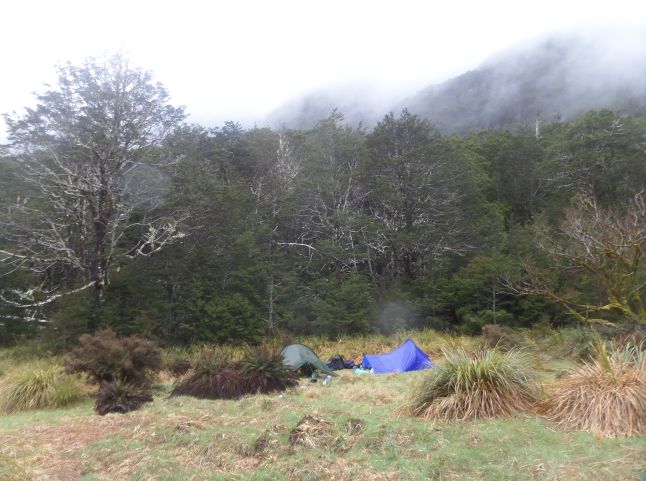
Quickly we set up the first fly, and the two coldest of us got underneath, changed into dry clothes and snuggled down into sleeping bags. Light rain fell intermittently, but again there’d been no wind at all. The second fly was put up and David set up his bivvy bag. We were pleased we had the smaller, less open flys as they afforded better shelter than one large fly would have. Some people had not brought groundsheets so foil emergency blankets had to substitute.
Next, we started on dinner: one billy for rice and another for the Thai green curry with tuna and vegetables. Trying to chop vegetables into pieces small enough to cook quickly was hard. My hands shook so much I had to take care to chop the carrots and not my fingers. We thought it would have been better to have had a quicker, easier meal to prepare and cook, but then, we thought we’d be preparing it at Cannibal Gorge hut, not standing in the open, all wet and cold. The light was fading and as soon as we’d eaten we got ready for a night under the flys (and bivvy bag).
Our position seemed unhopeful. What were we going to do the next day? We surveyed our remaining food supply and pondered how best to make it last. I thought about various items I’d removed from my pack before we’d left on Friday; it had seemed a lot heavier than usual. Now, I wondered if I would regret leaving them out.
We settled in for the night to the patter of rain, hoping for fine weather on Monday. My sleeping arrangements were surprisingly warm and comfortable (better than Friday night at Lake Rotoiti), though I wondered why I felt warm but my legs were shivering. David reported this too, and also discovered his bivvy bag was not ideally suited to wet weather. Catherine’s sleeping bag ended up against the side of the fly and got very wet, but happily for Catherine, its hydrophobic qualities kept her warm and dry.
Day Three/Monday: impromptu campsite by Pell Stream below saddle
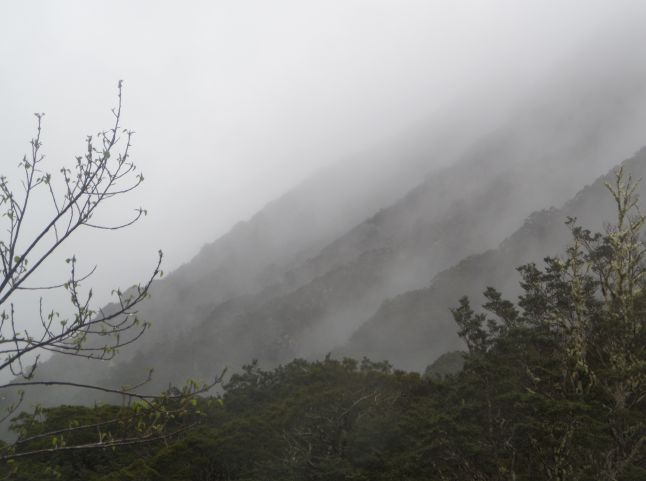
The rain continued off and on throughout the night. On Monday morning it appeared to be settling in for the rest of the day. As soon as it was light enough to assess the conditions, we discussed our options. To continue to the saddle was to risk one – or more – cases of hypothermia and if we needed to set off the PLB it would be a difficult place for searchers to get to us. Through breaks in the mist we could see that snow had fallen during the night up by the saddle. We thought about retracing our footsteps down the valley to Pell Stream hut and walking back to our starting point at Marble Hill. But hypothermia seemed just as likely to recur and with a diminishing quantity of dry clothing and energy-giving food and the possibility of a rising river, we felt the chances of running into trouble were also high. Our current position was the most favourable we were likely to find and there was room for a helicopter to land – if needed.
Catherine read aloud the PLB activation policy (kept with the device) to ensure we were not setting it off without proper cause. She activated the PLB at 7.30. About ten minutes later we heard it emit a series of short beeps as it connected with a search and rescue satellite (COSPAS-SARSAT). Catherine and David retreated under the shelter to write an explanation of the decisions that had led to setting off the PLB. I was already dressed in my wet tramping gear and chose to remain out in the rain, walking many circuits of the grassy clearing to keep warm. Everyone wore clothing made from the right kinds of fibres so while putting on wet clothes was unpleasant, it didn’t take too long to feel comfortably warm. We expected it would take at least two hours before help might arrive and possibly quite a lot longer, but at 9am David heard the approaching helicopter. We waited up by our campsite and watched as the red and yellow Canterbury Westpac Rescue helicopter circled lower and landed with great windy gusts further down in the centre of the open area.
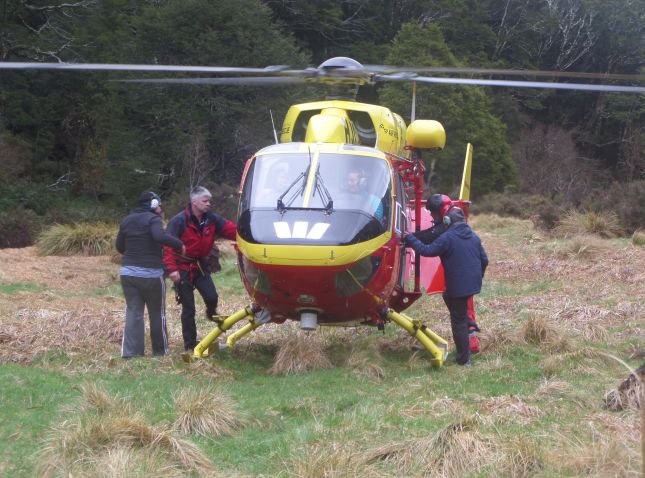
After discussing the situation with Catherine, the crew decided to ferry us back to Marble Hill in two groups. Quickly we packed up our gear and Catherine, Karen, and Erika took the first flight while I stayed back with David and paramedic Shane and inspected our campsite for any leftover items. Soon it was our turn. We strapped ourselves in, donned earmuffs, and lifted off. The journey took about 10 minutes. The pilot followed our route along Pell Stream to Frazer’s Flat and finally to the campsite at Marble Hill; the forested valleys looked spectacular. It was hard to believe we were out of the wilderness.
Catherine, David, Erika, Karen and I waved to the crew as they headed back to Christchurch, then changed into dry clothes. We paused at Maruia Springs for a hot beverage and a snack and compared our numerous bruises and abrasions. After a detour to reunite the Medium group with their van we headed to Picton, stopping for yet more food and coffee at Murchison.
So, why did we continue up the valley? From the start we were all very keen to attempt the saddle crossing, maybe too keen. As we moved toward the headwaters of Pell Stream we anticipated that its lower flow would make river travel more straightforward. We probably imagined beech forest to be easier terrain than it turned out to be. At the higher altitudes above the forest, the shrubland proved almost impenetrable, especially pushing uphill into it. Crossing the saddle from Cannibal Gorge hut down into the Pell Stream valley may have been a more suitable option. Our first brush with the edges of hypothermia should have been a warning sign to turn back because if it had happened once, it could recur. A valuable lesson learned.
Future plans
Contact Air Rescue Canterbury to express our gratitude and make a donation – tick;
Dry the flys, clean boots (very carefully), wash other gear, reproof rain jacket – tick;
In future read more widely on proposed routes and possible difficulties; improve navigational capabilities; pack carefully with an eye to what could happen when things don’t go to plan; remind people to always bring a groundsheet – and keep on tramping!
